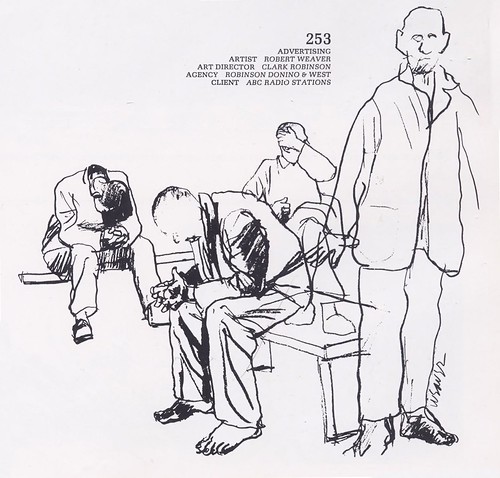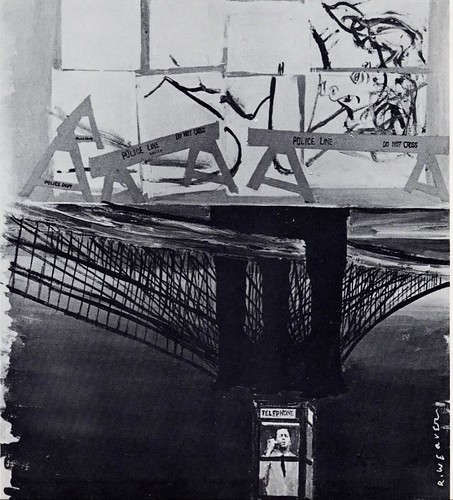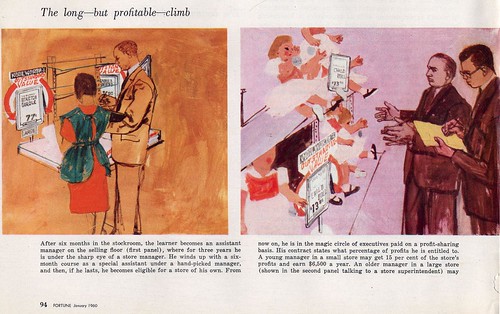
Considering what was the typical, broadly accepted style of illustration in the 50's, its hard to imagine work like this finding a home in any major magazine of the day.
But Robert Weaver began his career in 1952 and according to his biography at the Norman Rockwell Museum, he "produced powerful illustrations for such noteworthy clients as Esquire, Fortune, Sports Illustrated, Life, Look, The New York Times and Columbia Records" during the 50's (as well as the 60's and 70's).

The article there confirms what I was saying yesterday about this new breed of illustrators having one foot in the commercial art studio and the other in the fine arts gallery when it states, "Weaver was among the first to wed fine art to applied illustration" and goes so far as to call him "the godfather of the new illustration."

Weaver taught at Syracuse University and the School of Visual Arts for some 30 years, and these illustrations from the January 1960 issue of Fortune magazine are likely a good example of what he meant when he told his students, "stop being conceptual and get back to looking at things, at the details...to observe light and color and pattern."

Personally, while I can honestly say I respect Robert Weaver's philosophy and can appreciate the artistic merit in his work, I can't really say I "like" a lot of what I've seen so far (which I admit is not that much). Yesterday, an anonymous reader left a comment that, when Bernie Fuchs came on the scene, many art directors considered his work representative of the transition in illustrative style. In his article on Fuchs in Illustration #15, David Apatoff talks about how some art directors would not use the artist because his experimental techniques looked "a little too modern."
But now that we can look back and see a broader view of the landscape from a greater distance, one has to wonder; if Bernie Fuchs encountered resistance because his work was too experimental, how in the world did the likes of Robert Weaver fit into the scene at all?
Fuchs' work seems so much more accessible and yes, likeable, to me. I would guess the general public felt the same way since he became so widely imitated and so successful.
Robert Weaver on the other hand created work that I find kind of impenetrable and difficult to like. Perhaps that was his intention. I really don't know...

In spite of my confusion I suspect that what Robert Weaver did by leaping into mid-air was show others that it could - and should be done. Someone must take the daring plunge - and survive - to give others the courage to follow.
Illustrators needed to find a way out of the box that photography had trapped them in, and it was avant-garde pioneers like Robert Weaver who showed them the way.
* My thanks to Tom Watson and Dan Zalkus, who both provided art and information for today's post. Dan also made me aware of this facinating Robert Weaver slideshow of sketches from a 1962 Sports Illustrated assignment.
My Robert Weaver Flickr set.
Leif:
ReplyDeleteThis is great stuff. I can really see the influence of Weaver's stuff on certain cartoonists, especially Bill Sienkiewicz. I've always seen Robert Peak's influence on Sienkiewicz, but now it suddenly seems clear that Weaver must have been looked at, too.
Of course, there was a whole school of these guys, wasn't there? So maybe it's just the look in general. You mention Fuchs, and there's Peak... who else? At the risk of uncritically lumping all these guys together, their stuff is my favorite illustration style.
Anyway, hope there's more Weaver to come.
Did the future of illustration image go along with an article?
ReplyDeletethink Leif might have more Weaver in store for you, Jeffery. During the 50's and 60's, abstract expressionism became very popular among the Avant-garde' fine artists and a portion of the public. Compare the Avant- garde’ illustrators with the abstract expressionist like Larry Rivers, Richard Diebenkorn, David Parker and Elmer Bischoff, and you will see strong similarities. I have to believe that the abstract Expressionist movement played a part in the radical changes in illustration. I also think Weaver was a maverick, and didn't fit the mold of the literal 50's illustrators... not that he didn't have the skills, etc.
ReplyDeleteHa!... I remember debating this stuff back in the early 60's and now the same questions arise. I do know, in reading Weavers own words, that he felt the modern (1966) magazine illustrator must have something to say, as well as be an instigator. He also said, although the illustrator may use the ideas of the contemporary painter, it is communication that is his ultimate goal.
Tom Watson
Gutsy move this week, Leif.
ReplyDeleteI'm kind of on the fence with this stuff. It may have been a time of 'artistic freedom', but that also made it difficult to predict or plan one's next move. I love being able to sketch for myself, but to make a business out of that aspect of my art is a little murky to me. Untried territory is fine, but will it put food on the table?
Leif, Robert Weaver is certainly enjoying a resurgence these days. He got huge visibility in the New York Times last week, you have this nice post on him, and he is also being discussed in a series of posts over at D.B. Dowd's Graphic Tales blog. I made a point about him there that did not stir up the response I expected from Weaver fans, so forgive me for offering the same point again here:
ReplyDeleteI like Weaver's work a lot, especially his sketchbook drawings, and I am impressed by some of his strong and inventive designs.
However, I can't help but think that his mythic stature in the illustration field is more a result of his persona than his artwork. Weaver used to get drunk at the bar at the society of illustrators and caterwaul about how much he hated being an illustrator and selling out. This shook up all the young artists whose highest goal in life was to make it as an illustrator. Weaver was angry and articulate and dedicated to the notion that an artist should be an activist. This may make him an estimable fellow, but that does not always translate into quality artwork.
Weaver is worshipped as the great innovator, but if you compare how far Al Parker moved illustration from where he found it, with how far Weaver moved illustration, I would have to say that Parker was a more effective revolutionary, who explored a wider range of styles and approaches than Weaver did.
David-
ReplyDeleteYou have to realize that when Weaver came on the scene there was nobody like him. I've heard Marshall Arisman say that Weaver was a big influence on his decision to be an illustrator.
As to him being at the Society of Illustrators bar and being a drunk, what does that have to do with his work as an artist? Did you know that later in life he started to lose his eye sight? Or that he had a son who lost his life in a tragic accident?
Again I contest that what he did was an eye opener to many artists. I have a letter from Alex Toth that says as much. Jack Potter, a teacher and friend of mine, has said the same thing. He was also instrumental in having Weaver teach at the School of Visual Arts.
As for Al Parker he was a great artist in his own right but he's from a different time period. The one right before Weaver. That's when his style was less popular and he had to adapt and change. If you look at annuals in the 60's-70's you'll see less Parker work than you will in the 40's.
Dan, you and I agree exactly on the significance of Weaver being drunk at the bar of the society of illustrators; it should make no difference at all to his work as an artist. Yet, I think some of his peers gave him extra credit for having the sensitivity and the high ethics to be tormented by commercialism. Most illustrators were only too happy to "sell out" if they could get the work, but here was a successful illustrator cursing his fate and claiming there was a higher standard.
ReplyDeleteIt's a little like the legend of James Dean. Technically, it should have no impact on his merit as an actor, but how do you separate it?
I agree with you too about Parker. He softened up an earlier generation and helped pave the way for Weaver, but Parker was about 20years older.
'Sell out' ?
ReplyDeleteI think the vast unwashed, like me, call it making a living. I'm really lucky to be paid to draw for a living, but the moment I make my art a higher priority than supporting my family is the day I start being a really lonely artist.
I don't know Robert Weaver from a whole in the wall, but if it were me, the pressure of always being on the bleeding edge would definitely take a toll.
I had the fortunate experience of studying under Robert Weaver at the School of Visual Arts. Often people tend to view his work from a "cosmetic" perspective, which often puts some viewers in kind of an unconnected position to what he's actually trying to do. So many of us love to see beautiful draftsmanship and rendering. To Weaver if this was the primary objective of most illustrators, they were sort of selling themselves short. In terms of illustrations ability and effectiveness to have "a voice" and communication of thoughts and ideas in its role in media. As I've known and discovered over the years, the more you look into his work, his ideals and approach to picture making the more many will re-discover him for the visual genius that he truly was. Simply put, he believed in the illustrator as a thinker and visual activist, whose images presented the subject to you in a way that might cause you to view it in a more intrinsically honest and more thought provoking kind of way.
ReplyDeleteThanks for giving us the benefit of your thoughtful, insightful personal experience with Weaver, Michael. You provide some excellent perspective in what might have become a bit of lopsided argument ( due to the general tastes of those of us who are regulars here on this blog ). I have new-found respect for Weaver thanks to your explanation. :-)
ReplyDeleteAs both a huge fan of Al Parker and a former student of Robert Weaver. In times past Weaver has been in some circles called: "The Father of Modern Illustration. A title which I often support, because of the fact that there weren't any illustrators before or during his debut in 1952. Who viewed and practiced illustration from the role of performing a more activist role in print media. His approach to providing a more "authentic" and honest depiction of the subject matter was to whenever possible use an "on the spot" type of drawing. Often sketched right there in front of the subject. As opposed to a more "staged" "truth removed" approach of hired models, photography and projectors which were the standard working tools of the day. His absence of polished rendering in his work was a philosophical choice. Anyone who knew Weaver personally knew, the man could most certainly draw and paint well. His belief was almost akin to Jack Potter's where they believed drawing the foundation of their Illustrations from life brought you closer to the "truth" of the subject matter. I elaborate more on this in the article I wrote on Jack Potter in Illustration # 18. Al Parker bless his soul merely birthed legions of imitators. Weaver birthed generations of Illustrators who later practiced the craft from a conceptual,thinking visual journalistic standard. So I think Weaver's influence on Illustration in the end was a bit more. But for the record my personal favorites and heroes are the Cooper Studio aritsts. Who Weaver use to "jokingly" say to me, "Ah,The Cooper Studio,ha,ha,..They're my enemies"... Just thought I'd throw in my two cents.
ReplyDeleteThank you for the kind words regarding my contribution to the Robert Weaver discussion Leif. You've done Illustration's history a tremendous service with "Today's Inspiration". I thank people such as yourself, Dan Zimmer, Fred Taraba, Walt and Roger Reed, for your dedication to preserving and sharing the history of this great craft. You've done an excellent job. You've set the table Leif, and allowed everyone to bring something to it. So all of us lovers of Classic Illustration can enjoy and feast upon this great source of Inspiration.
ReplyDeleteMichael; Thanks once again for your comments and insight - and the benefit of your personal experience with Weaver! Each day on Today's Inspiration is a learning experience for me - and never more so than when readers share their knowledge and anecdotes. I really appreciate it!
ReplyDelete